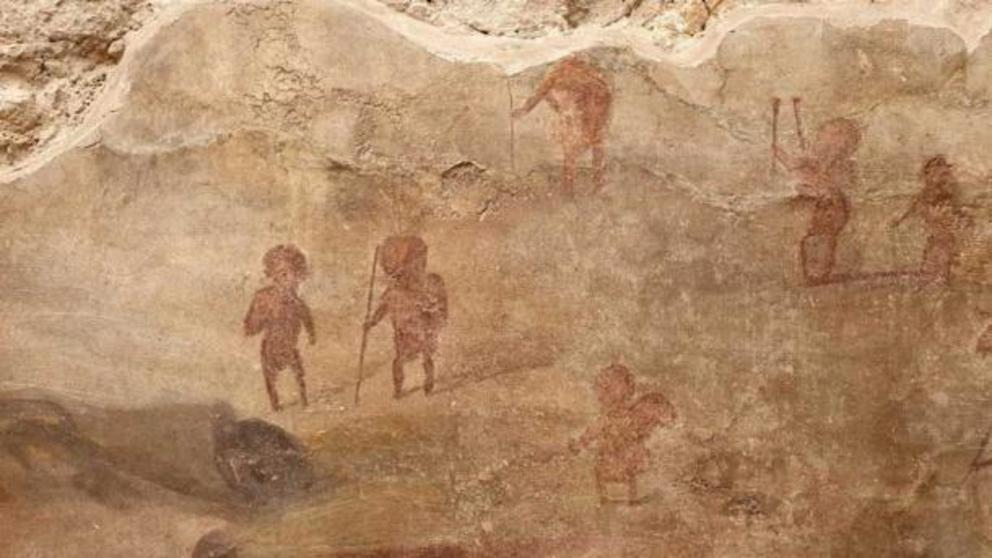Stunning Pompeii hunting fresco restored with laser
Top image: Refreshed Pompeii fresco in Casa dei Ceii
A 2,000-year-old painted hunting scene discovered in Pompeii has been painstakingly restored with lasers. However, this Pompeii fresco is not restricted to Roman hunting scenes, but also a range of wild Egyptian beasts associate the site’s owner with the ancient Egyptian cult of Isis.
The ancient hunting scenes featuring lions, leopards and a wild boar were discovered in the garden of Pompeii's “House of the Ceii,” that once belonged to the magistrate Lucius Ceius Secundus.
 The faded fresco before it underwent restoration.
The faded fresco before it underwent restoration.
The artwork was lost when Mount Vesuvius erupted in the year 79 AD, burying the cities of Pompeii, Oplontis, and Stabiae under ash and rock while the city of Herculaneum was buried beneath a mudflow. Every single resident instantly died in a 500°C pyroclastic surge that sent hot gasses and volcanic materials at speeds of around 450mph (700 km/h), and at temperatures of 1,000°C. This and many of the Pompeii frescos were almost lost forever.
An Illusionary Artwork Designed To Amplify Space
Lucius Ceius Secundus´s house, the “ Casa dei Ceii ” (House of the Ceii), was first uncovered in 1913–14, but subsequent neglect has caused the one time blazingly colorful fresco to fade. However, now, this exceptional ancient artwork has been restored and protected.
The restoration experts carefully retouched the painted areas of the Pompeii fresco that had been degraded over time, and damaged areas were cleaned with a special laser. And to protect the fresco from future damage from rainwater, special protective measures have also been taken.
 Vibrant hunting scene on the restored fresco.
Vibrant hunting scene on the restored fresco.
The vibrant hunting scenes were painted around 20-10 BC in what is known as the “Third” or “Ornate” Pompeii style. On the main section of the painting a lion pursues a bull while a leopard pounces on sheep, and a wild boar attacks a herd of deer. A Wanted In Rome article says frescos such as this one “commonly adorned the perimeter walls of Pompeiian gardens and were intended to evoke an atmosphere — often one of tranquility — while also creating the illusion that the area was larger than in reality, much as we use mirrors today.”
 In the wild scene, here a leopard pounces on sheep, dogs chase boars, and a lion pursues a bull.
In the wild scene, here a leopard pounces on sheep, dogs chase boars, and a lion pursues a bull.
Painting The Ancient Cult Of Isis
Site director Massimo Osanna told The Times what makes this fresco so special is that it’s complete, which he says is something “rare for such a large fresco at Pompeii.”
Not only did the archaeologists discover images of classical Roman hunting scenes at the Casa dei Ceii, but they also found sections showing “Egyptian-themed landscapes.” Wild beasts from the Nile delta include, for example: crocodiles and hippopotamuses that are shown being hunted by with African pygmies.
 Scenes from far and wide adorn other walls as Casa dei Ceii.
Scenes from far and wide adorn other walls as Casa dei Ceii.
Furthermore, an ancient ship is shown at sea transporting amphorae (clay liquid containers) which shuttled wines and luxury items around the Med. Therefore, this discovery leads the researchers to speculate that Lucius Ceius Secundus was perhaps associated with the “Cult of Isis,” which they say was popular among Pompeii elites in the city’s final years.
The Mysterious Egyptian Cult of Isis in the Ancient Roman Empire
According to the Temple of Isis Pompeii website the selection process by which priests/priestesses of the Temple of Isis were chosen remains a mystery, however, spiritual traditions maintain that the Goddess Isis herself chose her earthly administrators.
As experts in astrology, interpretation of dreams and conjuring of spirits, the priests and priestesses of the Temple of Isis fasted and practiced abstinence, and they worshiped their goddess several times a day and through the night. After the earthquake that hit Pompeii in 63 AD, one of the very few restored Temples was the Temple of Isis at Pompeii which is today an archaeological site located alongside the Triangular Forum.
The temple of Isis itself was designed for the worship of the cult of the Egyptian goddess by the same name, who appears both as a Roman deity and as her original Egyptian effigy. It is unknown just how deeply Lucius Ceius Secundus was involved with the cult of Isis, but to have commissioned frescos of Egyptian scenes in his garden he must have been somewhat into her.

